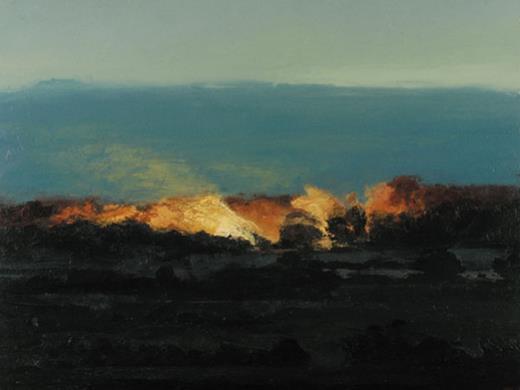The Australian National University’s Drill Hall Gallery has punched above its weight in recent months with celebrated shows by the late Roy Jackson, Sally Gabori and Ben Quilty, the latter emerging as something of a poster boy for contemporary Australian art. The result of a collaboration between Newcastle Art Gallery and the Tasmanian Museum and Art Gallery, Illumination: The Art of Philip Wolfhagen is a continuation of this trend. Having opened in Newcastle to widespread approbation in 2013, this insightful retrospective of the Tasmanian painter and printmaker has travelled to Canberra before heading to regional Queensland and Victoria.
The dynamic play of light and shadow across Wolfhagen’s oil and beeswax canvasses underlines the performative qualities of landscape. Wolfhagen’s luminous cloud studies – a series of Small Exaltations redolent of Constable and Turner – depict the natural world at its most transient. Nebulous forms billow and ebb above a landscape that is also in a constant state of growth and decay. And, like any performance, the landscape attains significance only in the presence of a human spectator. The landscape painter transmutes their three-dimensional surroundings into a scene capable of being recreated on canvas. Wolfhagen alludes to the complexity of this process when reflecting on Fieldworks (2002), a group of small canvases resulting from twelve days on Deal Island, Bass Strait: ‘the physical confrontations were nothing compared to the effort required in concentration to deal with the place and make sense of it artistically’. As a perceptual rather than a conceptual artist, Wolfhagen’s most powerful compositions are borne out of a deep affinity with the weathered landscapes and squalid colonial histories of northern Tasmania where he lives and works.
They are also the product of exhaustive – and, it would seem, exhausting – technical experimentation. Accompanying Wolfhagen’s finished works are the colour swatches used to determine the gradations of his palette, as well as his meticulously detailed visual diaries. The almost scientific scrupulousness with which Wolfhagen goes about his creative practice results in finished works of great technical complexity. In the foreground of Settlement III (2006), Wolfhagen has abraded the painting’s murky topcoat to expose a lighter hue, generating subtle contrasts in texture and tone. Wolfhagen’s signature is the split picture plane – used most effectively in Approach to first lagoon I (2004), a monumental work consisting of four separate canvases. The device may allude to Wolfhagen’s fascination with photography as it is often used to divide the composition into photo-like oblongs with traditional 4 x 5 dimensions. It also serves to remind the viewer that the artist’s framing of the landscape is ultimately arbitrary.
The Drill Hall is an austere but tranquil space that is probably insufficient for an exhibition of this scale. The show consists of some 54 works divided among three distinct rooms without any discernible theme. Although Wolfhagen’s tendency towards abstraction in recent years would have been conducive to a chronological format, this was probably not well suited to the Drill Hall’s disjointed layout.
Two of Wolfhagen’s most compelling works hang at the entrance to Gallery 1. Night Vision III (2006) and Settlement III (2006) are reminiscent of Whistler’s Nocturnes in which an otherwise sombre palette is punctuated by explosive pockets of light. Sadly this aesthetic experience is spoiled by the gallery’s unduly harsh lighting, which is reflected by the works’ dark painterly surfaces and doesn’t allow an unimpeded frontal view.
The repetition inherent in Wolfhagen’s creative practice could cause some to dismiss him as a bore – it must be admitted that his most abstract works, such as the Semaphores (2004), tend toward the monotonous. Rothko did all this about sixty years ago. But with Wolfhagen, patience is to be encouraged. At a time when one’s engagement with nature often amounts to a potted yukka on an apartment balcony, Wolfhagen gently encourages us to look up, and out.
Rating: 4 out of 5 starsIllumination: The Art of Philip Wolfhagen
Philip Wolfhagen
A Newcastle Art Gallery and Tasmanian Museum and Art Gallery traveling exhibition
The Australian National University Drill Hall Gallery, Kingsley Street, Acton
www.nag.org.au
20 February – 6 April 2014





